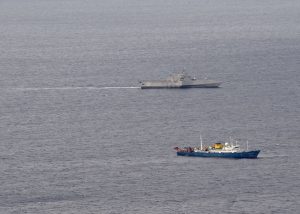Top diplomats from China and the United States have exchanged tense words over the long-running disputes in the South China Sea, underlining its status as a flash point for the escalating tensions between the two superpowers.
The comments came as the Association of Southeast Asian Nations (ASEAN) began a four-day run of Zoom-powered summitry in Hanoi.
The first salvos were fired by China’s Foreign Minister Wang Yi during his address to the 10th East Asia Summit Foreign Ministers’ Meeting on September 9. Citing the U.S. Navy’s recent activities in and around the disputed waterway, Wang accused Washington of interfering with the efforts of China and ASEAN countries to resolve the disputes through consultation. The U.S., he charged, was the “biggest driver of militarization” in the waterway and the “most dangerous factor damaging peace.”
Beijing’s expansive “nine-dash line” claim encloses the vast majority of the South China Sea, slicing off resource-rich swathes of ocean claimed by four ASEAN member states – Vietnam, Brunei, Malaysia, and the Philippines – in addition to Taiwan. As part of the broader souring of relations between Washington and Beijing, the U.S. recently toughened its stance on the South China Sea dispute, describing China’s claims to offshore resources across most of the contested waters “completely unlawful.”
Claiming that China’s true desire was “peace and stability” in the South China Sea, Wang attempted to position it as the victim of unprovoked American actions, building up fortified artificial islands as a defensive measure. “In the face of escalating military pressure from countries outside the region,” he said, “we certainly have the basic self-protection rights of sovereign states.”
Wang’s comments were consistent with Beijing’s depiction of the disputes as an intra-Asian issue that should not concern “outside powers.” By way of inducement, speaking at a separate ASEAN-China Ministerial Meeting later that day, the Chinese diplomat announced that the two sides should “finalize” a code of conduct as soon as possible to create “a set of rules that reflect the region’s characteristics.”
A Code of Conduct for the South China Sea has been a perennial item on ASEAN’s wish list, though progress towards a binding agreement has been slow. Separately, Philippine Foreign Affairs Secretary Teodoro Locsin said that negotiations over a Code of Conduct would resume no later than November.
At a ASEAN-U.S. Ministerial Meeting on September 10, Secretary of State Mike Pompeo reaffirmed the tougher American line on the South China Sea, and assailed China’s “bullying” of ASEAN claimants. “Don’t just speak up, but act,” he told his Southeast Asian counterparts. “Don’t let the Chinese Communist Party walk over us and our people. You should have confidence and the American will be here in friendship to help you.”
Wang’s attempt to play the victim is unlikely to assuage the concerns of nations facing the hard edge of Chinese naval power in the South China Sea, over which Beijing recently fired a barrage of missiles. Vietnam Foreign Minister Pham Binh Minh, in responding to Pompeo’s comments, said, “We welcome the U.S.’s constructive and responsive contributions to ASEAN’s efforts to maintaining the peace, stability and developments in the South China Sea.”
At the same time, Southeast Asian governments continue to harbor concerns about the Trump administration’s lurching policy toward the region. In particular, they worry that the stronger U.S. position on the disputed waterway is motivated overwhelmingly by its competition with China, and fear becoming the front line of a shooting war between the two superpowers. That connects to broader perceptions that the current administration will happily pledge undying support to the region and its interests one moment, and then fail to show up for key ASEAN meetings the next.
Heavily reliant on China’s economy, yet dependent on the U.S. for their security, few Southeast Asian claimants can afford to make the sort of grand gestures on the South China Sea that officials in Beijing and Washington would like to see. That Vietnam’s foreign minister was able to thank Washington for its support over the maritime disputes without ever mentioning China by name is indicative of the increasingly narrow line that the region has to walk.

































